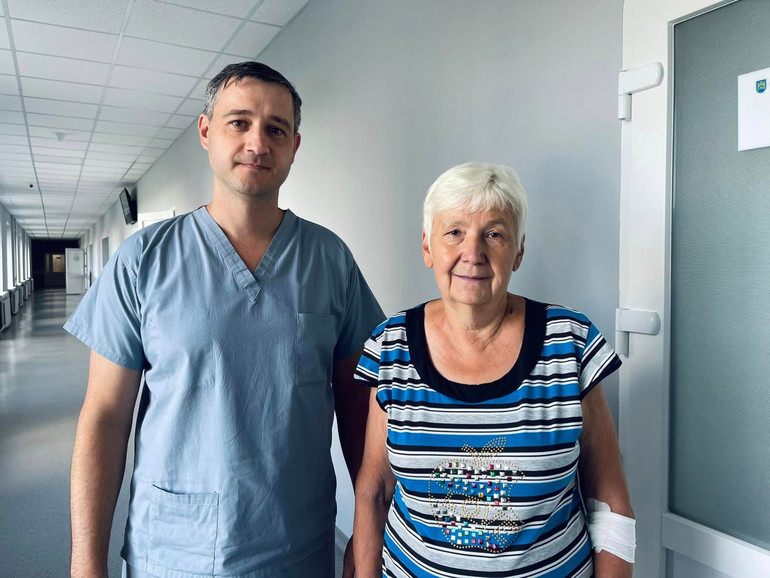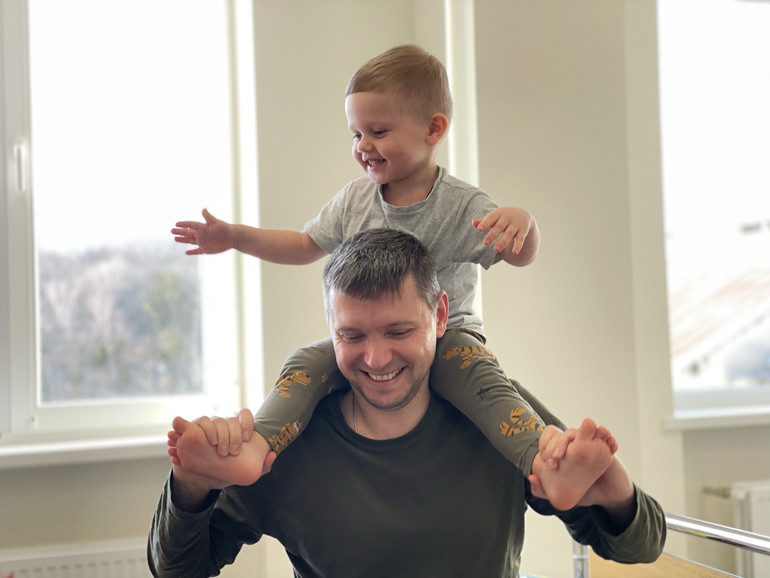How the da Vinci robot surgeon operates
[ad_1]
In February of this year, the first children’s robotic surgeon Da Vinci Si appeared in Ukraine. The robotic system arrived from the USA at the St. Nicholas Children’s Hospital of the First Medical Association of Lviv.
A robot surgeon has already helped doctors operate on an 11-year-old child with oncological pathology. The team of surgeons has already become one of the leaders of interventions performed with the help of the Da Vinci robot in Eastern Europe and operated on the smallest patient in this region – a child weighing 9 kg.
The appearance of a children’s robot surgeon opens new perspectives in the development of Ukrainian surgery, bringing it to the forefront of the world.
As a doctor and part of the team of the First Medical Association of Lviv, I have a unique opportunity to see all the changes in the medical field from the inside.
Raising Ukrainian medicine to the level of German, Swiss or American medicine is no longer a dream, but the story of hundreds of thousands of saved patients. In particular, the launch of robotic surgery helped us jump many years ahead in the level and quality of medical care.
What is the uniqueness of robotic surgeries and how do Ukrainian doctors expand the possibilities of their own eyes and hands? I will tell you from our experience.
How it works Da Vinci robotic surgeon
Over the past four years, the number of requests for medical help at the hospital of the First Medical Association of Lviv has tripled. Last year alone, we treated 479,000 patients. At the same time, every seventh patient required surgical intervention. In particular, the number of such operations in 2023 in our medical institution amounted to more than 67 thousand. Half of them are complex cases, many of which required an innovative approach.
It is also worth mentioning the fact that Lviv Oblast, which received the largest number of IDPs, faced additional challenges in the organization of medical care.
One of the most progressive responses to these challenges has been the integration of a robotic system into our work. This is a combination precise movements robotics with the experience of professional surgeons, which allows you to operate with jewel-like precision and control.
In fact, we can perform very complex procedures on any organ with a minimal incision. However, it is still more accurate and less traumatic than most minimally invasive interventions using traditional laparoscopy.
We used robotic surgery for the first time in 2020, when we received a robotic surgeon as a gift Da Vinci. The patient was a 50-year-old resident of Brody, who came to us with a suspicion of gastrointestinal bleeding, and a part of the stomach actually shifted into the chest cavity. The situation was critical.
We decided to perform the operation using a robotic system, which helped to eliminate the problem flawlessly. This was the first case among state medical institutions in Ukraine, when a patient was operated on using a surgical robotic system.
The first patient of the First Medical Association of Lviv during an operation with the help of the Da Vinci robot
Then our doctors and the Da Vinci robot were able to restore a patient from Bakhmut, who had a difficult diagnosis – “achalasia of the esophagus”, to a full life. For 30 years, the woman felt pain and discomfort in her stomach, could not eat and drink normally. She turned to us already in critical condition.
The best way to save the patient from pain and avoid fatal consequences was surgery with the help of a robotic system. After just a few punctures, the doctors dissected the muscular lining of the esophagus, easing the spasm, and also applied a so-called cuff to avoid throwing food from the stomach back into the esophagus.

A patient from Bakhmut after surgery with the help of the Da Vinci robot
Our surgeons also began to provide such modern care to children. Last year, we operated on a girl with a whole set of diagnoses related to a malfunction of the urinary system. It was a rather complex anomaly of the urinary tract: the child had a double kidney and ureter.
Our urologists, together with a team of surgeons and the Da Vinci robot, removed a fragment of the double kidney that was not performing its function. At the same time, the healthy part of the child’s organ remained intact.

An operation using the Da Vinci robot on a child’s kidney
This year was also marked by one of the most complex robotic interventions. Teams of urologists and surgeons of St. Nicholas Children’s Hospital saved the kidney of a 3-year-old boy from Kramatorsk.
The lower part of his organ did not work and was constantly inflamed due to the backflow of urine. The operation to remove the dangerous part was supposed to be done in 2022 – in Kherson. However, a full-scale invasion and occupation of the city got in the way. With the help of Da Vinci, the doctors performed the operation in just two hours without blood loss and with the least trauma for the patient.
They also restored the 16-year-old daughter of our defender to a full life by removing part of her spleen with cysts. She was on her feet two hours after such a difficult intervention.

A 3-year-old boy from Kramatorsk after surgery with the help of the Da Vinci robot
These are far from all the stories where robotic surgery has helped doctors fight the most complex pathologies. Since the appearance of the Da Vinci robot, we at the First Medical Association of Lviv have successfully operated on 45 adults and more than 40 children. These were complex general surgical, thoracic, urological, gynecological interventions, as well as even heart surgery and removal of a kidney from a donor during a family transplant.
Until now, surgeons from St. Nicholas Children’s Hospital shared one operating room with colleagues from our adult St. Panteleimon Hospital. However, with the arrival of another robot, we can significantly expand the range of care, especially for newborns, and perform state-of-the-art operations on twice as many children without transporting them to an adult hospital.
Does robotic surgery mean that a robot will operate on me?
I will answer immediately – no. And here’s why. Doctors use many technologies that enhance their capabilities and skills. For example, MRI and CT make it possible to “see” the patient’s condition from the inside.
Similarly, surgeons use a robotic system to operate in hard-to-reach places. This does not mean that you are being operated on by a robot. Da Vinci becomes an additional four “hands” and remains under the clear control of the doctor, who, through a special console, controls the instruments just a few meters from the patient. In summary, the main components of the robotic system will be named:
- robotic arms One hand has a special camera and provides an extended 3D visualization of the required area, two more with tools – repeat the movements of the doctor’s hands, wrists and fingers with high accuracy; the fourth – acts as an assistant;
- the control center of the surgeon-operator, where he sits at the console and directly controls the robotic arms during the intervention.
In the world, more than 14 million such operations using the Da Vinci robotic system have already been performed, and Ukraine is one of 70 countries that has such surgical devices, although so far there are only five for the entire country. This is an incredible success for our medicine, because we can talk about a fairly wide landscape of operative interventions in such directions as:
-
- cardiac surgery – correction of congenital heart defects or removal of tumors;
- general surgery – removal of hernias, gall bladder;
- urology – removal of kidney tumors and kidney stones, treatment of bladder cancer and prostate cancer, reconstructive urology;
- gynecology – treatment of abnormal bleeding, pelvic pain, endometriosis, treatment of uterine fibroids, ovarian cancer.
We are already connected with the last direction by the incredible story of a patient who was helped by Da Vinci to “solve” her infertility problem.
In July 2021, a 19-year-old girl came to us with complaints of constant pelvic pain and irregular menstrual cycle. Among the problems voiced was the fact that she cannot get pregnant.
Gynecologists then discovered a benign tumor, which in most cases needs to be removed. To do this in the least traumatic way and save the ovary, the Da Vinci system was used. Five months have passed since the operation, and during a planned visit to the First Medical Association of Lviv, the patient reported that she was pregnant.
More opportunities or barriers?
Undoubtedly, the robotic system allows us to perform operations with the best precision and minimal risks for the patient. It provides doctors with high dexterity, flexibility, better visibility of the operative site thanks to 3D imaging and 10-fold magnification. It is similar to using a laparoscope, but has more advantages.
The robotic “hand” will never tremble. She will perform the delicate movements of a surgeon, even surpassing human capabilities in some places. In addition, the use of a robot reduces the physical burden on surgeons and allows comfortable operation from the position of sitting on the surgical console. This is especially important during long and complex operations, when doctors have to stand over the operating table for ten hours at a time.
For the patient, this is a number of advantages both during and after the operation itself: reduction of blood loss, injuries and cuts, risks of infection and complications in the postoperative period, reduction of pain and discomfort, minimal scars, faster recovery and return to everyday life in 2-3 days after the intervention.
And although there are really many advantages, from our experience I will share the main challenges we faced:
- cost of equipment and consumables;
- the need for special training of surgeons and maintenance;
- patient trust, due to limited awareness of robotic surgery.
There are actually more opportunities than barriers. Therefore, the development of robotic surgery is a fully justified investment of time and money.
Despite the war and the constant attempts of the enemy to destabilize us, Ukraine can and should develop medicine. As a manager, I would say that now is the best time to borrow experience and technology. All medicine in the world, the best universities and clinics are currently open to our doctors.
You just need to learn and put it into practice. Of course, we can’t just take a European or American template and copy it, it doesn’t work like that. But we can take experience, the best technologies, finalize and implement it in Ukraine.
And we have to do it immediately, because the “window of opportunity” is not eternal, it will close soon. And we have no right to lose any opportunity to become better. For the sole purpose of saving Ukrainians at home and providing the highest quality services.
Oleg Samchuk, General Director of the First Medical Association of Lviv, urologist, specially for UP. Life
Publications in the “View” section are not editorial articles and reflect exclusively the author’s point of view.
[ad_2]
Original Source Link











